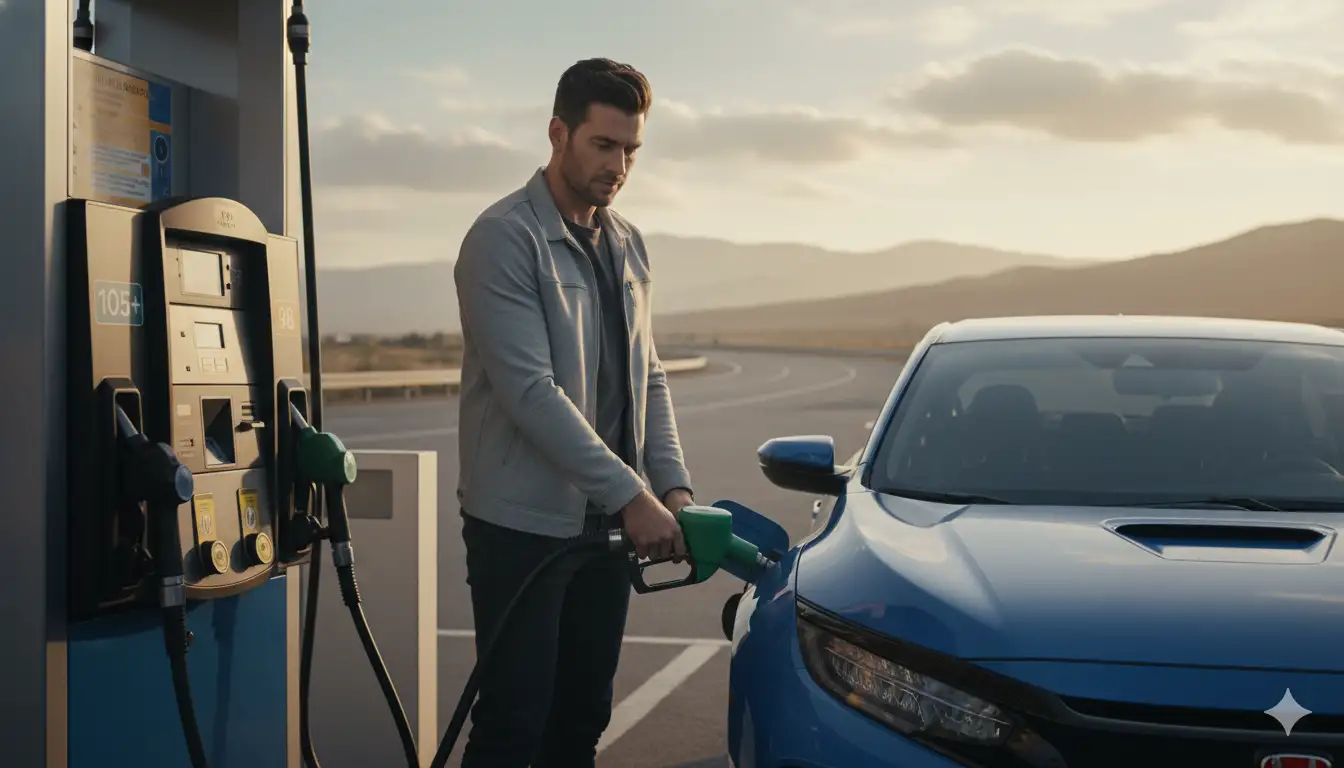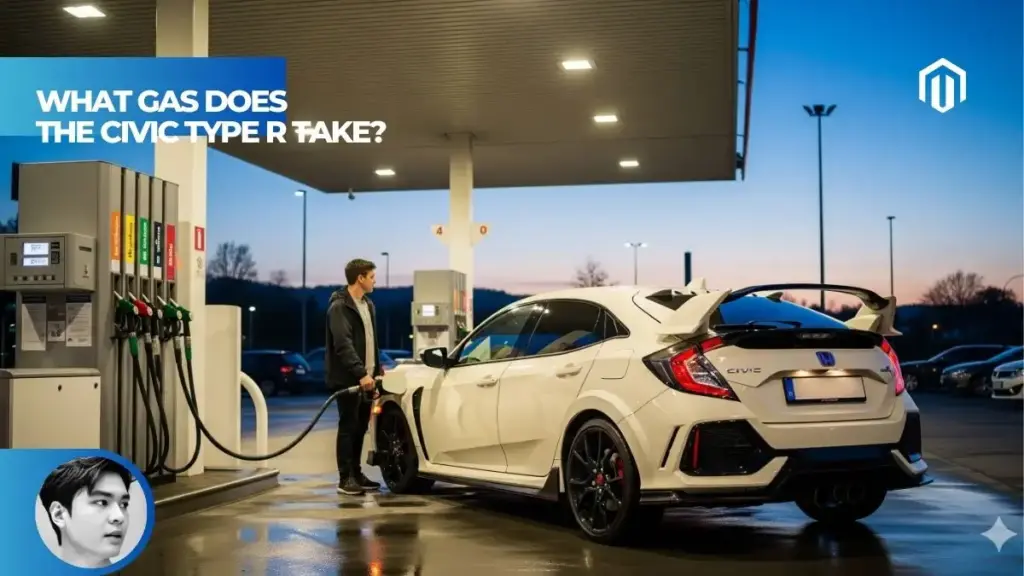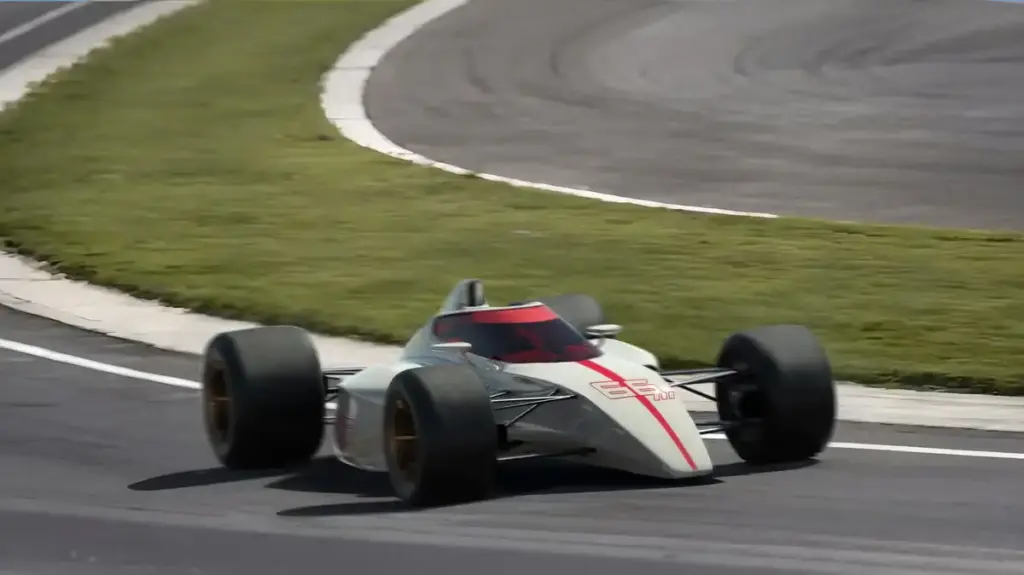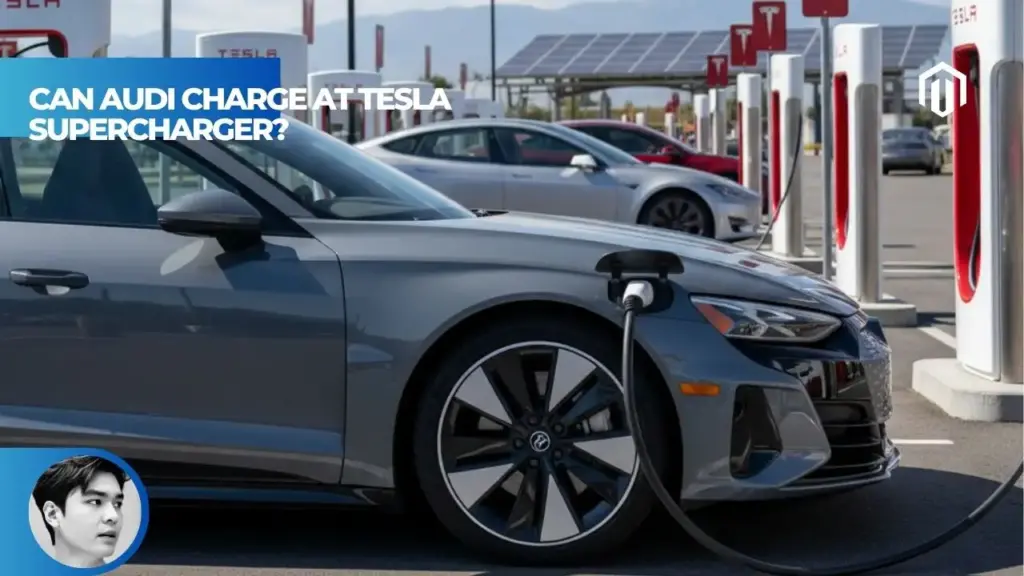You may also like:
- 【Explained】What Is the Gas Mileage of the R? (EPA vs. Real World)
- 【Explained】What Type of Gas Do BMW Take? Premium Fuel, Octane, and Knocking Explained
- 【Explained】Can Audi Run on Regular Gas? (A Full Guide on Recommended vs. Required Fuel)
- 【Explained】Why Does My Car Smell Like Gas but Isn’t Leaking?
- 【Explained】How to Get a Car with a Bad Fuel Pump to Start? (Temporary Hacks)
The Honda Civic Type R requires premium unleaded gasoline with a minimum 91 octane rating for proper performance, though Honda’s documentation states “Regular Unleaded (Premium Recommended).” Using 93 octane delivers the full 315-320 horsepower advertised, while 87 octane triggers knock sensors that significantly reduce power output to protect the engine.

The Direct Answer – Civic Type R Fuel Requirements
Understanding the exact fuel requirements for your Civic Type R ensures you maintain peak performance while protecting your high-compression turbocharged engine. The confusion around fuel specifications stems from Honda’s somewhat contradictory documentation that lists regular unleaded as acceptable but strongly recommends premium.
Civic Type R Premium Gas Required (91 Octane Minimum)
The 2025 Honda Civic Type R officially requires premium unleaded gasoline with a minimum 91 octane rating to achieve its advertised performance specifications[1]. This requirement applies to all Type R models from 2017 onward, including both the FK8 and current FL5 generations. The high-performance K20C1 engine features a compression ratio optimized for premium fuel, allowing it to generate 315-320 horsepower depending on model year.
Honda Civic Type R Fuel Recommendation vs Requirements
Honda’s documentation creates confusion by stating “Regular Unleaded (Premium Recommended)” on official spec sheets[1]. However, this doesn’t mean regular gas is optimal:
| Fuel Type | Official Status | Real-World Impact |
|---|---|---|
| 87 Octane | Minimum acceptable | Significant power loss, ECU protection mode |
| 91 Octane | Recommended minimum | Near-full performance |
| 93 Octane | Optimal choice | Full advertised horsepower |
According to Autvex’s analysis of owner experiences and technical data, treating 91 octane as the true minimum requirement ensures you experience the Type R’s intended performance characteristics.
FL5 Civic Type R Fuel Type (2023-2025)
The current FL5 generation Civic Type R (2023-2025) maintains the same fuel requirements as its predecessor, calling for premium unleaded with 91+ octane[2]. Learn about the FL5’s impressive fuel economy when using the recommended premium fuel. The updated K20C1 engine in the FL5 produces 315 horsepower and 310 lb-ft of torque when properly fueled.
FK8 Civic Type R Fuel Type (2017-2021)
The FK8 generation (2017-2021) established the modern Type R’s fuel requirements, specifying the same 91 octane minimum for its turbocharged 2.0-liter engine[3]. These models pioneered Honda’s high-output turbo technology in the Civic platform, requiring premium fuel to manage the increased cylinder pressures and heat generation inherent in forced induction.
Understanding Octane Ratings for the Type R
Octane ratings measure fuel’s resistance to premature detonation under compression, critical for turbocharged engines operating at high boost pressures. The Type R’s sophisticated engine management system adapts to different octane levels, but performance varies significantly.
Civic Type R 91 Octane Performance
Running 91 octane provides approximately 95-98% of the Type R’s maximum performance potential. The engine control unit (ECU) can optimize timing and boost pressure effectively with 91 octane, delivering strong acceleration and responsiveness. Most owners report minimal difference between 91 and 93 octane in daily driving conditions.
Civic Type R 93 Octane Benefits
Using 93 octane unlocks the Type R’s full performance envelope, allowing the ECU to advance ignition timing for maximum power output[4]. Benefits of 93 octane include:
- Full 315-320 horsepower output
- Optimal torque curve delivery
- Slightly improved throttle response
- Maximum efficiency under hard acceleration
- Best lap times on track
Is 93 Octane Better for Type R Than 91?
Yes, 93 octane provides measurable performance advantages, particularly during spirited driving or track use. Independent testing shows gains of 5-10 horsepower and improved mid-range torque when comparing 93 to 91 octane[4]. However, for daily commuting, the difference remains subtle enough that 91 octane suffices for most owners.
Top Tier Gas for Civic Type R
Honda recommends using Top Tier certified gasoline regardless of octane rating[5]. Top Tier fuel contains enhanced detergent packages that:
Benefits of Top Tier fuel:
- Reduce carbon buildup on intake valves
- Maintain fuel injector cleanliness
- Prevent deposits in combustion chambers
- Extend engine component life
Major brands offering Top Tier certification include Shell, Mobil, Chevron, and BP.
What Happens If You Put Regular Gas in a Civic Type R?
Using regular 87 octane gasoline triggers immediate protective measures from the Type R’s engine management system. Understanding these consequences helps explain why premium fuel isn’t merely a suggestion for this high-performance engine.
Civic Type R Engine Knock with 87 Octane
When detecting knock events from 87 octane fuel, the Type R’s knock sensors immediately signal the ECU to implement protective strategies[6]. Similar protective systems exist in other performance vehicles. The engine experiences micro-detonations that, while inaudible to drivers, register clearly on sensitive piezoelectric knock sensors.
Civic Type R Power Loss with Regular Gas
Using 87 octane results in substantial power reduction, often 30-50 horsepower, as the ECU pulls timing and reduces boost pressure[6]. Real-world symptoms include:
- Sluggish acceleration from stops
- Reduced passing power on highways
- Longer 0-60 times (increased by 1-2 seconds)
- Decreased top-end power above 5,000 RPM
How the ECU Retards Timing to Protect the Engine
The Type R’s ECU employs sophisticated algorithms to prevent engine damage when running sub-optimal fuel:
| Protection Method | Implementation | Effect |
|---|---|---|
| Timing retard | Delays spark timing | Reduces peak cylinder pressure |
| Boost reduction | Limits turbo pressure | Decreases heat and stress |
| Fuel enrichment | Adds extra fuel | Cools combustion chambers |
| Rev limiting | Lowers redline | Prevents high-RPM damage |
Will 87 Gas Damage Your Civic Type R?
Occasional use of 87 octane won’t cause immediate damage thanks to protective systems, but consistent use risks long-term consequences[2]. Potential issues from regular 87 octane use include:
- Accelerated carbon buildup
- Premature turbocharger wear
- Increased engine bearing stress
- Reduced catalyst life
- Potential warranty complications
Emergency Situations and Wrong Fuel
Sometimes circumstances force Type R owners to use sub-optimal fuel. Knowing how to minimize potential damage proves crucial during these situations.
Accidentally Put Regular Gas in Civic Type R – What Now?
If you’ve accidentally filled with 87 octane, take these immediate steps:
- Don’t panic – The engine won’t fail immediately
- Drive conservatively – Avoid full throttle acceleration
- Keep RPMs moderate – Stay below 4,000 RPM when possible
- Add octane booster if available (temporary solution)
- Dilute with premium at next opportunity
According to Autvex experts, one tank of regular gas driven gently won’t cause lasting damage to a healthy Type R engine.
Can a Civic Type R Run on Regular Gas Temporarily?
Yes, the Type R can operate on 87 octane temporarily without catastrophic failure, as Honda designed the engine management system to protect itself[1]. However, this should remain an emergency-only situation, not a cost-saving strategy.
Driving Guidelines When Using 87 Octane
If forced to use regular gas, follow these guidelines to minimize stress:
Emergency driving tips with 87 octane:
- Accelerate gradually, avoiding sudden throttle inputs
- Maintain steady highway speeds
- Avoid aggressive downshifting
- Skip sport mode entirely
- Allow longer warm-up periods
- Reduce payload when possible

Model Year Specific Fuel Requirements
While fuel requirements remain consistent across Type R generations, understanding model-specific details helps owners maintain their vehicles properly.
2024 Civic Type R Gas Type
The 2024 Civic Type R requires premium unleaded with minimum 91 octane, identical to other FL5 generation models[1]. Compare with premium fuel requirements in other performance vehicles. Honda made no changes to fuel specifications for the 2024 model year.
2023 Civic Type R Gas Type
As the first year of the FL5 generation, the 2023 Type R established current fuel requirements of 91+ octane premium unleaded. This model introduced revised engine internals but maintained the same compression ratio and boost levels requiring premium fuel.
2021 Civic Type R Gas Type (FK8)
The final FK8 model year continued requiring 91 octane minimum for its 306 horsepower output. These models featured the same K20C1 engine as earlier FK8s, with identical fuel requirements despite minor ECU tuning updates.
2018 Civic Type R Gas Type (FK8)
The 2018 Type R, part of the FK8’s second model year, specified the same premium fuel requirements established at the generation’s launch. Early adopters discovered the importance of premium fuel through reduced performance when using regular gas.
K20C1 Engine Fuel Type and Technical Details
The K20C1 engine represents Honda’s pinnacle of four-cylinder turbo technology, requiring specific fuel characteristics to operate as designed.
High-Compression Turbocharged Engine Requirements
The Type R’s K20C1 features a 9.8:1 compression ratio combined with up to 23 psi of boost pressure[3]. This combination creates extreme cylinder pressures demanding fuel that resists detonation:
Technical specifications requiring premium fuel:
- Compression ratio: 9.8:1
- Maximum boost: 23 psi (FL5)
- Peak cylinder pressure: Over 1,000 psi
- Combustion temperature: Exceeding 2,000°F
Why the K20C1 Engine Needs Premium Unleaded
Premium fuel’s higher octane rating provides several critical benefits for the K20C1:
- Detonation resistance during high boost operation
- Stable combustion at advanced timing angles
- Consistent power delivery across RPM range
- Thermal management under sustained loads
- Catalyst protection from excessive heat
Engine Management System and Knock Sensors
The Type R employs dual knock sensors monitoring each cylinder bank for detonation events[6]. Understanding warning systems helps prevent damage. These piezoelectric sensors detect vibrations indicating pre-ignition:
| Component | Function | Response Time |
|---|---|---|
| Knock sensors | Detect detonation | <1 millisecond |
| ECU processing | Analyze frequency | <5 milliseconds |
| Timing adjustment | Retard ignition | <10 milliseconds |
| Boost control | Reduce pressure | <50 milliseconds |
Related Honda Performance Models Fuel Comparison
Understanding fuel requirements across Honda’s performance lineup provides context for the Type R’s premium fuel needs.
What Gas Does Civic Si Take?
The Civic Si recommends 91 octane but accepts 87 as minimum, similar to the Type R’s documentation[7]. However, the Si’s lower-output 1.5-liter turbo engine tolerates regular gas better than the Type R’s high-strung 2.0-liter.
Civic Si fuel comparison:
- Engine: 1.5L turbocharged
- Power: 200 horsepower
- Compression: 10.6:1
- Boost: Lower than Type R
- 87 octane impact: Less severe
What Gas Does a Regular Civic Sport Take?
Standard Civic Sport models run perfectly on 87 octane regular unleaded. Similar to many non-performance vehicles, these naturally aspirated or mildly turbocharged engines don’t require premium fuel for optimal operation.
Acura Integra Type S Gas Type (Same Engine)
The 2024+ Acura Integra Type S shares the K20C1 engine with the Civic Type R, requiring identical 91+ octane premium fuel[8]. This badge-engineered variant produces the same 315 horsepower when properly fueled.
Fuel Optimization and Alternatives
Maximizing Type R performance involves understanding fuel options beyond standard pump gas, though most alternatives prove impractical for street use.
Civic Type R 91 vs 93 Octane Performance Difference
Real-world testing reveals measurable but modest differences between fuel grades:
| Metric | 91 Octane | 93 Octane | Difference |
|---|---|---|---|
| Peak HP | 310-312 | 315-320 | +5-8 hp |
| Peak Torque | 308 lb-ft | 310 lb-ft | +2 lb-ft |
| 0-60 mph | 5.1 sec | 4.9 sec | -0.2 sec |
| Quarter mile | 13.6 sec | 13.5 sec | -0.1 sec |
Can I Use E85 in a Civic Type R?
No, the Type R cannot use E85 without extensive modifications. Honda explicitly warns against ethanol content exceeding 10%[5]. E85 requires:
- Different fuel injectors
- Modified fuel pump
- ECU recalibration
- Potential internal upgrades
Using E85 in a stock Type R will cause running issues and potential engine damage.
Octane Booster for Civic Type R
Octane boosters offer temporary solutions when premium fuel isn’t available, though effectiveness varies:
Octane booster considerations:
- Most add 1-3 octane points maximum
- Cost often exceeds premium fuel price
- Some contain harmful additives
- Not recommended for continuous use
- Emergency use only
Autvex recommends carrying a bottle for emergencies but relying on proper pump gas for regular use.

Key Takeaway
The Honda Civic Type R requires premium unleaded gasoline with a minimum 91 octane rating for proper operation, with 93 octane recommended for optimal performance. Using 87 octane regular gas will trigger knock sensors, causing the ECU to reduce power significantly and potentially damage the engine long-term.
The Type R’s high-compression turbocharged K20C1 engine was engineered specifically for premium fuel. While Honda’s documentation states regular unleaded is acceptable, this represents the absolute minimum for emergency situations only. Real-world testing confirms substantial power loss and increased wear when using sub-optimal fuel.
Owners should treat 91 octane as the true minimum requirement, with 93 octane delivering the full performance Honda intended. The small additional cost of premium fuel protects your investment while ensuring you experience the Type R’s legendary performance capabilities.
Next Steps
Always fill your Civic Type R with 91+ octane premium fuel, use 93 octane when available for best performance, and only use 87 octane in absolute emergencies while driving gently until you can refuel with premium.
Start by locating Top Tier certified gas stations in your area that consistently offer 91 or 93 octane fuel. If shopping for a Type R, factor premium fuel costs into your budget—approximately $300-500 annually over regular gas.
For current owners using regular gas, switch to premium immediately to restore full performance and protect your engine. If you’ve been using 87 octane regularly, consider having your dealer inspect for carbon buildup or other issues during your next service.
Track day enthusiasts should always use 93 octane and consider data logging to monitor knock events. The marginal cost difference between 91 and 93 becomes negligible compared to the performance gains during aggressive driving.
Keep emergency octane booster in your vehicle for unexpected situations where premium fuel isn’t available. Plan fuel stops on road trips to ensure access to appropriate octane levels.
Finally, join Type R owner forums and communities where members share fuel quality experiences and station recommendations in various regions. Understanding local fuel availability helps maintain your Type R properly throughout its ownership.
Frequently Asked Questions
What gas does the Honda Civic Type R take?
The Civic Type R requires premium unleaded gasoline with a minimum 91 octane rating, with 93 octane recommended for achieving the full 315-320 horsepower output as designed by Honda.
Do I have to use premium gas in a Civic Type R?
Yes, premium gas (91+ octane) is effectively required for proper engine operation, though Honda’s documentation states “Regular Unleaded (Premium Recommended)” as a technical minimum for emergency situations only.
What is the minimum octane for a Civic Type R?
The absolute minimum is 87 octane according to Honda’s specifications, but this causes significant power reduction and potential long-term damage, making 91 octane the practical minimum for regular use.
Will 87 octane (regular gas) damage my Civic Type R?
Occasional use won’t cause immediate damage due to protective knock sensors and ECU adjustments, but consistent use of 87 octane can lead to carbon buildup, premature wear, and reduced engine life.
What happens if I put regular gas in a Type R by accident?
The knock sensors detect detonation and the ECU automatically reduces timing and boost pressure, resulting in noticeable power loss of 30-50 horsepower while protecting the engine from damage.
Does Honda recommend or require premium gas for the Type R?
Honda’s documentation shows “Regular Unleaded (Premium Recommended)” but the high-compression turbocharged engine effectively requires 91+ octane to achieve advertised performance and maintain reliability.
Is 93 octane better for the Type R than 91?
Yes, 93 octane allows the engine to produce full advertised horsepower with optimal timing advance, providing 5-8 additional horsepower and slightly improved acceleration compared to 91 octane.
Does the Civic Type R (FL5) and the old one (FK8) take the same gas?
Yes, both FL5 (2023-present) and FK8 (2017-2021) generations require the same premium unleaded 91+ octane fuel for their K20C1 turbocharged engines.
Does the Civic Si also need premium gas?
The Civic Si recommends 91 octane for optimal performance but tolerates 87 octane better than the Type R due to its lower-output 1.5-liter turbocharged engine with less aggressive tuning.
What’s the difference in performance between 87 and 91 gas in a Type R?
Using 87 octane causes approximately 30-50 horsepower reduction, slower acceleration (0.5-1.0 seconds slower to 60 mph), reduced throttle response, and the ECU operates in protective mode limiting performance significantly.
References
- Honda. (2025). 2025 Civic Type R Features & Specifications. Retrieved from https://automobiles.honda.com/civic-type-r/specs-features-trim-comparison
- CivicXI Forum. (2024). Required Fuel Type Discussion. Retrieved from https://www.civicxi.com/forum/threads/required-fuel-type.53875/
- Car and Driver. (2024). 2025 Honda Civic Type R Review and Specifications. Retrieved from https://www.caranddriver.com/honda/civic-type-r
- Car and Driver. (2019). Premium Gas Testing Results. Retrieved from https://www.caranddriver.com/features/premium-gas-worth-it
- Honda Engines. (2023). Fuel Recommendations. Retrieved from https://engines.honda.com/support-and-service/fuel-recommendations
- CivicXI Forum. (2024). Knock Sensor and Fuel Grade Discussion. Retrieved from https://www.civicxi.com/forum/threads/fuel-grade.52019/
- Reddit CivicSi. (2024). Premium Gas Requirements Discussion. Retrieved from https://www.reddit.com/r/CivicSi/comments/18jzuks/
- Acura. (2024). Integra Type S Specifications. Retrieved from manufacturer documentation

I am a senior automotive analyst at Autvex. Expert vehicle evaluations, in-depth reviews, and objective analysis helping readers make informed automotive decisions with years of industry experience.








